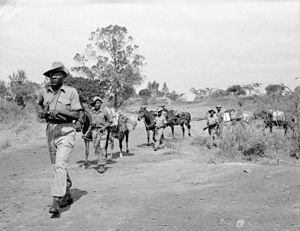Mau Mau rebellion
Insurgency in Kenya from 1952 to 1960 / From Wikipedia, the free encyclopedia
Dear Wikiwand AI, let's keep it short by simply answering these key questions:
Can you list the top facts and stats about Mau Mau uprising?
Summarize this article for a 10 years old
The Mau Mau rebellion (1952–1960), also known as the Mau Mau uprising, Mau Mau revolt, or Kenya Emergency, was a war in the British Kenya Colony (1920–1963) between the Kenya Land and Freedom Army (KLFA), also known as the Mau Mau, and the British authorities.[5]
| Mau Mau rebellion | |||||||
|---|---|---|---|---|---|---|---|
| Part of the decolonisation of Africa | |||||||
 Troops of the King's African Rifles on watch for Mau Mau rebels | |||||||
| |||||||
| Belligerents | |||||||
|
Mau Mau rebels[A] | |||||||
| Commanders and leaders | |||||||
|
(1951–1955) (1955–1957) (1957–1960) |
Dedan Kimathi Musa Mwariama Waruhiu Itote Stanley Mathenge (MIA) | ||||||
| Strength | |||||||
|
10,000 regular troops 21,000 police 25,000 Kikuyu Home Guard[1][2] | unknown | ||||||
| Casualties and losses | |||||||
| 3,000 native Kenyan police and soldiers killed[3] |
12,000-20,000+ killed (including 1,090 executed)[4] 2,633 captured 2,714 surrendered | ||||||
Dominated by Kikuyu, Meru and Embu fighters, the KLFA also comprised units of Kamba[6] and Maasai who fought against the European colonists in Kenya, the British Army, and the local Kenya Regiment (British colonists, local auxiliary militia, and pro-British Kikuyu).[7][8]
The capture of rebel leader Field Marshal Dedan Kimathi on 21 October 1956 signalled the defeat of the Mau Mau, and essentially ended the British military campaign.[9] However, the rebellion survived until after Kenya's independence from Britain, driven mainly by the Meru units led by Field Marshal Musa Mwariama. General Baimungi, one of the last Mau Mau leaders, was killed shortly after Kenya attained self-rule.[10]
The KLFA failed to capture widespread public support.[11] Frank Füredi, in The Mau Mau War in Perspective, suggests this was due to a British divide and rule strategy,[12] which they had developed in suppressing the Malayan Emergency (1948–60).[13] The Mau Mau movement remained internally divided, despite attempts to unify the factions. On the colonial side, the uprising created a rift between the European colonial community in Kenya and the metropole,[14] as well as violent divisions within the Kikuyu community:[4] "Much of the struggle tore through the African communities themselves, an internecine war waged between rebels and 'loyalists' – Africans who took the side of the government and opposed Mau Mau."[15] Suppressing the Mau Mau Uprising in the Kenyan colony cost Britain £55 million[16] and caused at least 11,000 deaths among the Mau Mau and other forces, with some estimates considerably higher.[17] This included 1,090 executions by hanging.[17] The rebellion was marked by war crimes and massacres.
